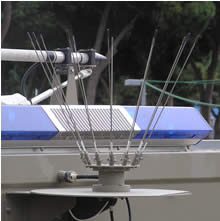Urban guerillas have also learned to make use of the benefits of network centric communications, using modern technologies such as wireless phones, cellular networks, and the Internet. Their communications merge with normal commercial traffic as the guerillas try to evade Signal Intelligence (SIGINT) monitoring. With careful preparation (including legal approval) and persistent surveillance by SIGINT specialists, commercial communications can be monitored in order to provide valuable operational intelligence. Commercial communications targeted SIGINT requires special equipment that mimics a cellular communications cell, diverting subscriber communications traffic from the commercial cell without the subscriber’s knowledge, and then analyzing it and passing the transmissions back to the commercial network. This process enables monitoring, identifying, and tracing specific subscribers and even tapping selected calls.
Other means are available for tapping into central cellular and Telephone Company (TELCO) switchboards, allowing intelligence agencies to screen thousands of calls and intercept communications between suspects based on voice signature, or usage of specific words, names, or locations. Similar activities performed over the Internet include ‘data mining’ e-mail and Internet traffic for valuable intelligence. In order to be considered ‘valuable’, information does not have to include words such as “bomb” or “IED.” Data mining can be accomplished using criteria that are more general, including usage patterns, communication with known or suspected IP addresses and traffic to and from specific locations.
 Remote activation of explosive devices is another capability of commercial communications used by urban guerillas. Wireless phones, remote control equipment, and infrared remote controls are some of the activation devices that have been used by insurgents in the Middle East for the past few decades. Military forces are countering this threat with a wide range of countermeasures, constantly improved to attempt to stay ahead of evolving threats. Consequently, unlike common Information Warfare operations, where jammers are only employed by specialist Electronic Warfare units, Urban Combat (UC) and SASO require the use of IED Jammers by every combat vehicle, EOD team and even by dismounted patrols. This trend has led to the development of reliable, effective, “switch on and forget” jammers that can effectively combat remote triggering of IEDs without degradation of the vehicle’s or individual’s communications system. This type of electronic warfare has created many electronic engineering challenges.
Remote activation of explosive devices is another capability of commercial communications used by urban guerillas. Wireless phones, remote control equipment, and infrared remote controls are some of the activation devices that have been used by insurgents in the Middle East for the past few decades. Military forces are countering this threat with a wide range of countermeasures, constantly improved to attempt to stay ahead of evolving threats. Consequently, unlike common Information Warfare operations, where jammers are only employed by specialist Electronic Warfare units, Urban Combat (UC) and SASO require the use of IED Jammers by every combat vehicle, EOD team and even by dismounted patrols. This trend has led to the development of reliable, effective, “switch on and forget” jammers that can effectively combat remote triggering of IEDs without degradation of the vehicle’s or individual’s communications system. This type of electronic warfare has created many electronic engineering challenges.
Additional parts of this article:
- The Challenges of Command and Control in Urban Operations
- The urban electromagnetic environment
- Information Warfare in urban Combat
- Effects Based Operations (EBO) in urban Combat
- Situational Assessment (SA) in urban Combat
- Backing the Vigilant Eyes ISR Networking for Urban Combat
- Accelerating the kill chain Closing the Sensor-to-shooter Cycle



















